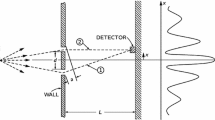Abstract
Although there is good experimental evidence for the Aharonov–Bohm phase shift occurring when a solenoid is placed between the beams forming a double-slit electron interference pattern, there has been very little analysis of the relevant classical electromagnetic forces. These forces between a point charge and a solenoid involve subtle relativistic effects of order v2/c2 analogous to those discussed by Coleman and Van Vleck in their treatment of the Shockley–James paradox. In this article we show that a treatment exactly analogous to that given by Coleman and Van Vleck predicts classical electromagnetic forces which provide the basis for the Aharonov–Bohm phase shift. The magnetic force on the solenoid due to the passing charge leads to a displacement of the solenoid center of energy which must be balanced by the displacement of the passing charge. This classical displacement of the passing charge is exactly what is required to account for the Aharonov–Bohm phase shift. Also, we discuss a magnetic moment model which appears frequently in the literature and note that although the model provides conservation of linear momentum, it does not satisfy the general requirements for relativistic theories. We give an example suggesting that the new equation of motion for a magnetic moment proposed by Aharonov, Pearle, and Vaidman based upon the hidden momentum of the magnetic moment is completely inappropriate. Finally, we emphasize that the Aharonov–Casher phase shift is also explained by classical electromagnetic forces exactly parallel to those explaining the Aharonov–Bohm phase shift.
Similar content being viewed by others
REFERENCES
Y. Aharonov and D. Bohm, Phys.Rev. 115, 485 (1959).
See, for example, R.G. Chambers, Phys.Rev.Lett. 5, 3 (1960) or G.Mollenstedt and W.Bayh, Naturwissenschaften 49, 81 (1962).See also the reviews by S.Olariu and I.I.Popescu, Rev.Mod.Phys.57, 339 (1985) and by M.Peshkin and A.Tonomura, “The Aharonov_Bohm effect,” in Lecture Notes in Physics, Vol.340 (Springer, New York, 1989).
S. Coleman and J.H. Van Vleck, Phys.Rev. 171, 1370 (1968).
W. Shockley and R.P. James, Phys.Rev.Lett. 18, 876 (1967).
R.G. Chambers, Phys.Rev.Lett. 5, 3 (1960).
G. Matteucci and G. Pozzi, Phys.Rev.Lett. 54, 2469 (1985).
A.W. Overhauser and R. Colella, Phys.Rev.Lett. 33, 1237 (1974).R.Colella, A.W.Overhauser, and S.A.Werner, Phys.Rev.Lett.34, 1472 (1974).
See, for example, R.J. Cook, H. Fearn, and P.W. Milonni, Am.J.Phys. 63, 705 (1995), or T.H.Boyer, Am.J.Phys.40, 56 (1972).
T.H. Boyer, Phys.Rev.D 8, 1679 (1973), and Nuovo Cimento B 100, 685 (1987).
T.H. Boyer, Phys.Rev.D 8, 1667 (1973).
See, for example, J.D. Jackson, Classical Electrodynamics, 2nd edn. (Wiley, New York, 1975), p.172.
See Ref.4 and also W.H. Furry, Am.J.Phys. 37, 621 (1969).
See Ref.3, p.1370.
See Ref.3, p.1372.
See, for example, Ref.11 end papers.
See T.H. Boyer, Phys.Rev.D 8, 1667 (1973) for related but different manipulations related to the vector potential.
See Ref.3, p.171.
Reference 3, Eq.(9).
T.H. Boyer, Nuovo Cimento B 100,685 (1987).
Y. Aharonov, P. Pearle, and L. Vaidman, Phys.Rev.A 37, 4052 (1988) and L.Vaidman, Am.J.Phys. 58, 978 (1990).
Y. Aharonov and A. Casher, Phys.Rev.Lett. 53, 319 (1984).
A. Cimmino, G.I. Opat, A.G. Klein, H. Kaiser, S.A. Werner, M. Arif, and R. Clothier, Phys.Rev.Lett. 63, 380 (1989).
T.H. Boyer, Phys.Rev.A 36, 5083 (1987).
See, for example, the presentation by A.G. Klein, Physica B 137, 230 (1986).
See, for example, David J. Griffiths, Introduction to Electrodynamics, 2nd edn. (Prentice–Hall, Upper Saddle River, New Jersey, 1981), p.247, or J.D.Jackson, Ref.11, p.185.
See, for example, David J. Griffiths, Introduction to Electrodynamics, 3rd.edn. (Prentice- Hall, Upper Saddle River, New Jersey, 1999), pp.520–521; P.Penfield and H.Haus, The Electrodynamics of Moving Media (M.I.T.Press, Cambridge, MA, 1967), p.215; L.Vaidman, Am.J.Phys.58, 978 (1990); S.Coleman and J.H.Van Vleck, Phys.Rev.171, 1370 (1968), footnote 9.
W.K.H. Panofsky and M. Phillips, Classical Electricity and Magnetism (Addison–Wesley, Reading, MA, 1955), p.270.
See, for example, Ref.11, p.181.
See, for example, Ref.11, p.657.
See, for example, Ref.25, p.162.
L. Page and N.I. Adams, Am.J.Phys. 13, 141 (1945).
See, for example, Ref.11, p.552.
Author information
Authors and Affiliations
Rights and permissions
About this article
Cite this article
Boyer, T.H. Classical Electromagnetism and the Aharonov–Bohm Phase Shift. Foundations of Physics 30, 907–932 (2000). https://doi.org/10.1023/A:1003654508964
Issue Date:
DOI: https://doi.org/10.1023/A:1003654508964



